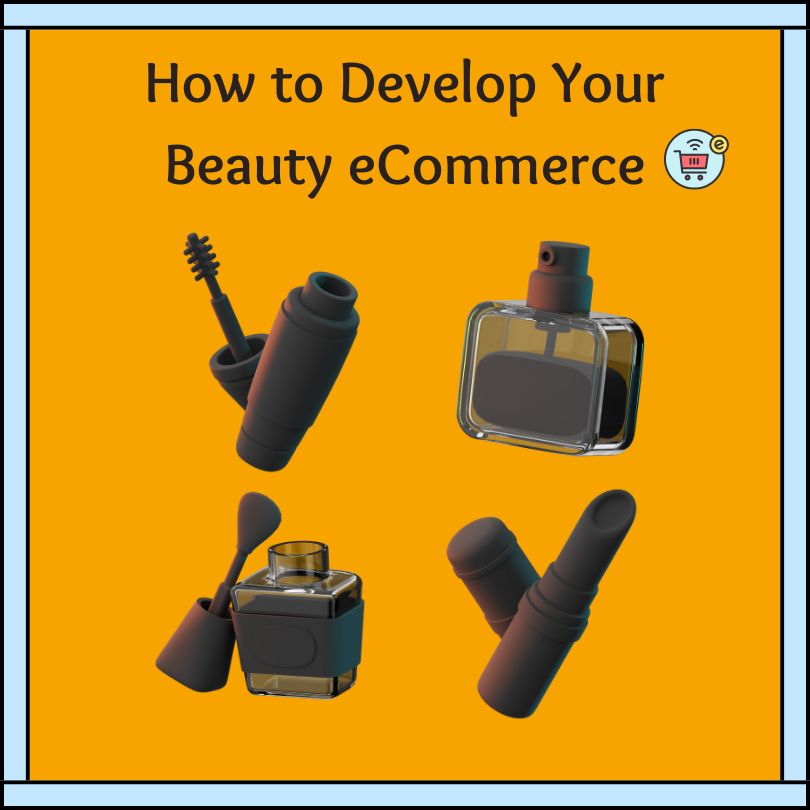Whether you agree with the saying 'Beauty lies in the eye of the beholder' or not, beauty has always symbolized power. Consumers are willing to invest in products that promise to improve their appearance, making beauty eCommerce a lucrative industry. As a result, many choose to enter this venture, hoping to achieve success in a highly competitive field.
Yet, only those who understand what it takes to stand out will succeed in the beauty industry eCommerce.
In this article, we’ll cover everything from tips to trends and examples.
Key Facts You Should Know About Beauty eCommerce
Beauty eCommerce centers around the online retail of beauty products such as skincare, cosmetics, haircare, and wellness items. Some of the most successful beauty eCommerce brands include Glossier, Fenty Beauty, and The Ordinary, which have revolutionized the industry with their strong brand identities and direct-to-consumer approaches. However, one doesn’t necessarily need extensive resources and investments to thrive; Deciem, Drunk Elephant, and Briogeo are great examples. They all identified a gap in the beauty market and a unique selling proposition (USP), allowing them to build profitable brands.
The following are a few intriguing facts that may nudge you to start building your business plan:
- The global beauty industry brings in over $100 billion in annual revenue, with North Asia and North America being the leaders.
- When facing financial challenges, many still purchase beauty products as an accessible means of self-care and emotional upliftment, known as the “lipstick effect.” This tendency highlights how small luxuries, like makeup or skincare, help maintain a sense of control and confidence, even as larger expenses are scaled back.
- A 2023 survey found that Millennials were the largest group of online beauty shoppers globally (48 percent), followed by Gen Z at 35 percent.
- As social media’s influence grows, more people buy beauty products through apps, with TikTok leading in the U.S., followed by Instagram and Facebook. TikTok excels in live sales and video promotions, driving high engagement for beauty brands like Dyson, Cerave, and Deciem.
- Skincare and makeup are in the top three trending products on Shopify, while beauty is the fifth best-selling category on Amazon.
If these facts inspired you to take the first step towards creating your beauty eCommerce, let’s explore how to start.
How to Develop Your Beauty eCommerce
Here’s a step-by-step guide for everyone aiming to create beauty products eCommerce websites.

1. Decide Your Niche and Unique Value Proposition (UVP)
Your niche is a specific segment of the beauty industry where you can provide specialized products or services, making it easier to reach a relevant audience. Potential niches include clean beauty, vegan cosmetics, anti-aging skincare, or products tailored for specific skin tones or hair types.
Since each niche has its unique audience, the one you choose should depend on market demand, personal expertise, and competitor analysis. Moreover, you must identify your UVP to understand what sets your brand apart from others in the same niche. This could be a commitment to cruelty-free ingredients, eco-friendly packaging, or an emphasis on inclusivity.
The following are examples of beauty eCommerce brands that mastered their UVP.
- Good Molecules: This brand carved out a niche by focusing on affordable, science-backed skincare while highlighting ingredient transparency. Its UVP is based on effective, budget-friendly products without unnecessary packaging or marketing fluff.
- Versed: A clean, vegan skincare brand that’s highly affordable. Versed targets eco-conscious, price-sensitive consumers with a UVP of providing non-toxic beauty essentials that deliver results.
2. Define Your Audience
After deciding your niche and UVP, explore the specifics of those likely to buy your products.
Here’s how to do it.
Analyze Beauty Submarkets
The beauty industry is wide and diverse, and each submarket appeals to different demographics. Some of the key submarkets are:
Skincare
While skincare is popular across age groups, you must consider they all have different needs. Younger consumers typically focus on acne solutions, while older demographics seek anti-aging products.
Makeup
This submarket often appeals to younger consumers, especially Gen Z and Millennials, as they’re more likely to follow social media trends. Brands like Morphe and ColourPop cater to this group with trendy, affordable products.
Haircare
These brands often target consumers based on hair type (curly, straight, thin, etc.), and demographics like ethnicity and age.
Clean Beauty
Clean beauty primarily attracts eco-conscious, health-focused consumers. These customers, usually Millennials and Gen Z, are drawn to brands like Drunk Elephant and Biossance, which emphasize clean, non-toxic ingredients.
Luxury Beauty
This submarket targets an affluent demographic, often 35+, with a higher disposable income. Brands like Chanel and Tom Ford Beauty are favorites among consumers craving prestige and high-quality products.
Use Customer Segmentation Tools
You can identify your audience by analyzing the following:
- Age: Teenagers and young adults might focus on trendy (especially those viral on TikTok) or affordable products, while older consumers may prioritize anti-aging or high-end skincare.
- Gender: While traditionally focused on women, the men’s personal care market is expected to reach $276.9 billion by 2030. For example, brands like Harry’s and Beardbrand target male consumers with specialized products.
- Income: It goes without saying that budget-conscious consumers prefer affordable brands like The Ordinary, while luxury shoppers gravitate toward high-end offerings.
- Lifestyle: People have different needs, priorities, and affinities, dictating their lifestyle choices. For example, wellness and clean beauty enthusiasts value natural ingredients and ethical sourcing.
- Ethnicity: Different skin types and hair textures can impact product needs. Brands like Fenty Beauty appeal to a diverse audience with their broad range of foundation shades, while SheaMoisture targets consumers with curly and textured hair.
3. Choose Your Beauty eCommerce Format
If you took the route of securing partnerships with at least 30 brands, consider a multi-brand store with competitive prices and fast service. On the flip side, if you want to work with one or two brands, create a site that functions as an expert guide and solves specific beauty concerns like aging or acne.
In case you have your own beauty products, you can still develop a guide-like store but focus on showcasing what sets your brand and offerings apart, whether it’s the ingredients, formulation, or mission.
4. Choose the Right Platform
Budget, scalability, ease of use, and design flexibility should be the main guides of your decision. However, the most popular platforms are:
- Shopify: Its user-friendly design makes it ideal for beginners
- WooCommerce: This platform is great for those familiar with WordPress and looking for customization.
- BigCommerce: If you want to create a larger store with high scalability, this should be your first choice.
- Magento: This one is excellent for enterprises needing extensive customization and resources.
5. Decide Your Website Design
Although beauty industry eCommerce websites should have a clean, user-friendly design that reflects the brand’s identity, the layout depends on your target audience. Younger shoppers typically favor trendy and aesthetic websites with vibrant colors, bold fonts, and interactive elements. However, a more minimalistic, elegant design with straightforward navigation may work better for older audiences.
Skincare-focused stores are more appealing if they have clean, soothing aesthetics with neutral tones to signal trust and professionalism. Meanwhile, makeup brands can experiment with playful, edgy designs to highlight self-expression. In every case, high-quality images, clear product descriptions, and easy checkout are a must-have.
6. Choose the Essential Features of Your Beauty eCommerce Website
Think about your target audience, product type, and business goals when deciding the key store features. However, every beauty eCommerce website should have the following to ensure a stellar UX:
- User-friendly interface, including intuitive navigation, effective search functionality, and clear categorization of products to make it easy for customers to find what they need.
- A secure, streamlined checkout process with multiple payment options, transparent shipping information, and hassle-free return policies.
- Mobile optimization, as many shoppers explore and purchase using their phones.
- Personalized product recommendations based on customer preferences and browsing history.
- Live chat for immediate customer support.
- A comprehensive FAQ section to answer common questions.
7. Create Your Beauty eCommerce Content Strategy
Content strategy for eCommerce websites aims to attract and engage audiences through relevant and captivating content. This is where high-quality formats, such as blog posts, tutorials, and product guides, enter the picture.
Storytelling should help you humanize your brand, while well-researched keywords should improve rankings and organic traffic. You can also include social proof (e.g., testimonials, reviews) to instill trust and distribute your content on platforms your audience uses the most. Moreover, dynamic content like Reels and TikToks can demonstrate your products, while viral campaigns, such as challenges or influencer collaborations, can create buzz and drive traffic.
8. Think About the Packaging
Packaging design for beauty products is as important as the item inside because it shapes first impressions and reflects brand identity. Keep in mind that your niche and audience should dictate the aesthetics of your packages.
Luxury beauty products go best with high-end packaging like sleek, elegant boxes with minimalistic designs. This accentuates the premium feel and a sense of exclusivity.
Eco-conscious consumers, on the other hand, prefer sustainable, recyclable materials that convey environmental responsibility. Consider surprising and interactive packaging for younger shoppers, as this encourages them to share the unboxing experience on social media.
Another thing to remember is personalization. — Adding the customer’s name or a personalized note is sure to create a deeper connection.
For example, some brands, like Glossier, use branded stickers and reusable pouches, which appeal to their youthful, social-media-savvy audience.
9. Prioritize Great Customer Experience (CX)
An effective eCommerce CX starts with recognizing your customers as humans with diverse needs. You can tap into those needs, preferences, and challenges by using customer segmentation and empathy mapping.
Moreover, your beauty eCommerce should be fast, mobile-optimized, and easy to navigate. Intuitive layouts, clear categories, and user-friendly search functionality all help accomplish that.
You can take CX to another level with striking visuals and interactive features like AR try-ons.
10. Let AI Do the Work for You
Generative AI has been making waves across industries, and not taking full advantage of it when creating beauty product eCommerce websites means missing out. With AI-powered tools, you can hyper-personalize product recommendations based on customer preferences, skyrocketing your engagement and conversion rates.
This advanced technology can automate content creation, such as product descriptions, blogs, and social media posts. If that’s not enough reason to give AI a try, you can also use it to automate inventory management and supply chain forecasts. Predicting demand based on past purchases and creating smoother restocking and delivery processes? You guessed right.
Beauty eCommerce Trends for 2024 and Beyond
When starting beauty eCommerce, you must know what’s trending in the industry and whether to integrate it into your strategy.
Personalization and AI
According to The State of Personalization 2024 survey, 89 percent of decision-makers perceive personalization as vital for their business in the next three years. In the 2020s, that is synonymous with AI and predictive analytics, especially in the cookieless future.
However, most businesses are focusing on personalizing eCommerce content for Gen Z, shifting towards a more dynamic and responsive personalization model. This requires collecting and processing data in real time.
Beauty eCommerce stores should also stop simply responding to what customers have done and instead create tailored experiences before the customer even asks. Finally, they should prepare for AI personalizing product delivery in the next five years and making it more human-like across the entire experience.
Even More AI
AI is already helping customers find the right products without visiting physical stores. One standout example is Proven, a skincare brand that uses AI to create personalized formulas that match individual skin types, lifestyles, and environmental factors.
Proven’s Skin Genome Project analyzes data from skincare ingredients, products, testimonials, and scientific research, asking users to complete a quiz to match products to their needs. The brand also adjusts formulas every eight weeks to accommodate changes in skin tolerance, seasons, and lifestyle.
Loyalty Programs
Seventy percent of U.S. consumers are more likely to stay loyal to brands that offer rewards. For instance, programs like 100% PURE’s Purist Perks provide customers with seasonal savings, birthday gifts, and points-based rewards, while their Purist Pro program offers discounts and early access to new products for professionals.
Interaction with Brand Communities
Beauty eCommerce brands are increasingly building communities to create meaningful interactions and stronger relationships with customers. For instance, The Skin Nerd’s “Nerd Network” has a dedicated community that offers educational content, personalized consultations, and skincare advice.
Another good example is Cocokind, which engages its 315,000 Instagram followers in product development through #Cocokindlab, encouraging customer input on packaging, ingredients, and more. Thanks to making them more involved, brands make customers feel valued and invested, nurturing loyalty.
Conclusion
Creating a high-performing beauty eCommerce site with a strong conversion rate is a multi-step process. Although there are countless guides available, turning your vision into a profitable store involves a long journey.
To accelerate it, consider teaming up with professionals who offer eCommerce website development services. This won’t only speed up the work, but also ease the learning curve, bringing you closer to online success.





